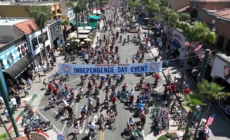-
How the U.S. Captured One of Mexico’s Biggest Drug Lords - 11 mins ago
-
Mets’ Kodai Senga Exits First Start of Season With Injury - 28 mins ago
-
Fresno County man sentenced for sexually assaulting children, dog - 31 mins ago
-
Doused by Rain, Paris Opens Its Games With a Boat Party on the Seine - 55 mins ago
-
How to Watch Men’s Tennis at the 2024 Paris Olympics: Streams, Schedule - about 1 hour ago
-
Photos: Paris is the backdrop for a colorful Olympics opening ceremony - about 1 hour ago
-
NASCAR News: This Is Where Corey LaJoie Could Go After Spire Motorsports Exit - 2 hours ago
-
Bullet or Fragment of One Struck Trump’s Ear, F.B.I. Says - 2 hours ago
-
Violent demonstration outside L.A. synagogue sparks second lawsuit - 2 hours ago
-
Donald Trump’s Protester Comments Raise Key Issues - 2 hours ago
Opinion | How the Baltimore Bridge Collapse Could Snarl U.S. Supply Chains
The immediate impact of the collapse of the Francis Scott Key Bridge in Baltimore on Tuesday was viscerally clear: In minutes, the Baltimore Harbor went from a humming logistics hub to a chaotic search and rescue operation. Two construction workers who had been fixing potholes on the bridge were pulled from the water, with six more missing and presumed dead.
As a native of Maryland, I grew up driving through the Baltimore Beltway with my family to see the Orioles play at Camden Yards, which is near Baltimore’s Inner Harbor. Seeing container ships sail through the port was one of my earliest memories of global shipping.
Last year, the Port of Baltimore processed 1.1 million 20-foot containers worth of cargo, making it the ninth busiest port based on trade volume in the United States and the most important port serving our nation’s capital. It’s also the busiest U.S. port for car shipments, with more than 800,000 vehicles moving through its waters onto its docks and across its roads and railways in 2023.
As rescue workers and salvage crews work tirelessly to recover bodies and restore access to the harbor, our national supply chain is kicking into high gear to absorb the aftershock of the bridge collapse. Ship traffic to the Port of Baltimore is being rerouted to nearby ports, including one in Norfolk, Va., and the Port of New York and New Jersey. These changes come at a time when global supply chains are already stressed, with ships changing course to avoid Houthi attacks in the Red Sea and low-water restrictions limiting capacity through the Panama Canal. The looming contract expiration for the International Longshoremen’s Association in September also creates uncertainty for businesses that rely on cargo sent by sea.
As a result of all this precarity, many companies that typically move goods through East Coast ports are already asking about rerouting their cargo through West Coast ports, opting to truck or rail the goods across the country to avoid delays. Ports around the country are preparing to absorb a surge in volumes as companies reroute around the Port of Baltimore and avoid the East Coast more generally.
If there’s one lesson we learned about the supply chain in recent years, it’s that sudden increases in container volumes arriving in U.S. ports can compound into congestion and delays. This was most evident during the peak of the pandemic-induced supply chain crisis, when over 100 ships were waiting off the coast to unload at U.S. ports.
We don’t yet know what caused the power loss that led to the crash in Baltimore or what could be done to avoid tragedies like this in the future. As we mourn the loss of life, what’s obvious to those of us in the shipping industry is that chronic underinvestment in America’s ports makes them ill-suited to handle the surging volumes they are likely to experience, as traffic planned for Baltimore is shifted to neighboring ports.
America’s ports are vital to American interests and are the backbone of our economy. Yet some of our largest ports can only handle vessels two-thirds the size of the world’s largest and most efficient container ships, which today primarily sail on the Asia to Europe trade lane, avoiding the United States altogether.
While recent plans by the Biden administration to invest billions in new, U.S.-manufactured container cranes appear to be a step in the right direction, it remains to be seen whether we’ll actually be getting larger, more efficient cranes capable of servicing the biggest ships, or if we’re simply replacing the existing cranes with similar models while doing little to improve the throughput of our ports.
America’s supply chain infrastructure is central to our country’s prosperity. We should invest far more to dredge our ports and enable them to handle larger ships, build new rail connections, automate port operations and implement container dispatching software to increase the throughput of trucks loading and delivering containers. The failure to do so leaves us weaker and more vulnerable when catastrophe strikes.
The good news is that the technology already exists off-the-shelf and has been successfully implemented in ports around the world. Port modernization would lead to high-paying jobs in and around American ports, while making our infrastructure and economy more resilient to shocks like the one we’re experiencing today in Baltimore.
Ryan Petersen is the chief executive of Flexport, a supply chain technology and logistics company.
Source images by THEPALMER/Getty Images and Nathan Howard/Reuters.
The Times is committed to publishing a diversity of letters to the editor. We’d like to hear what you think about this or any of our articles. Here are some tips. And here’s our email: letters@nytimes.com.
Follow the New York Times Opinion section on Facebook, Instagram, TikTok, WhatsApp, X and Threads.


















